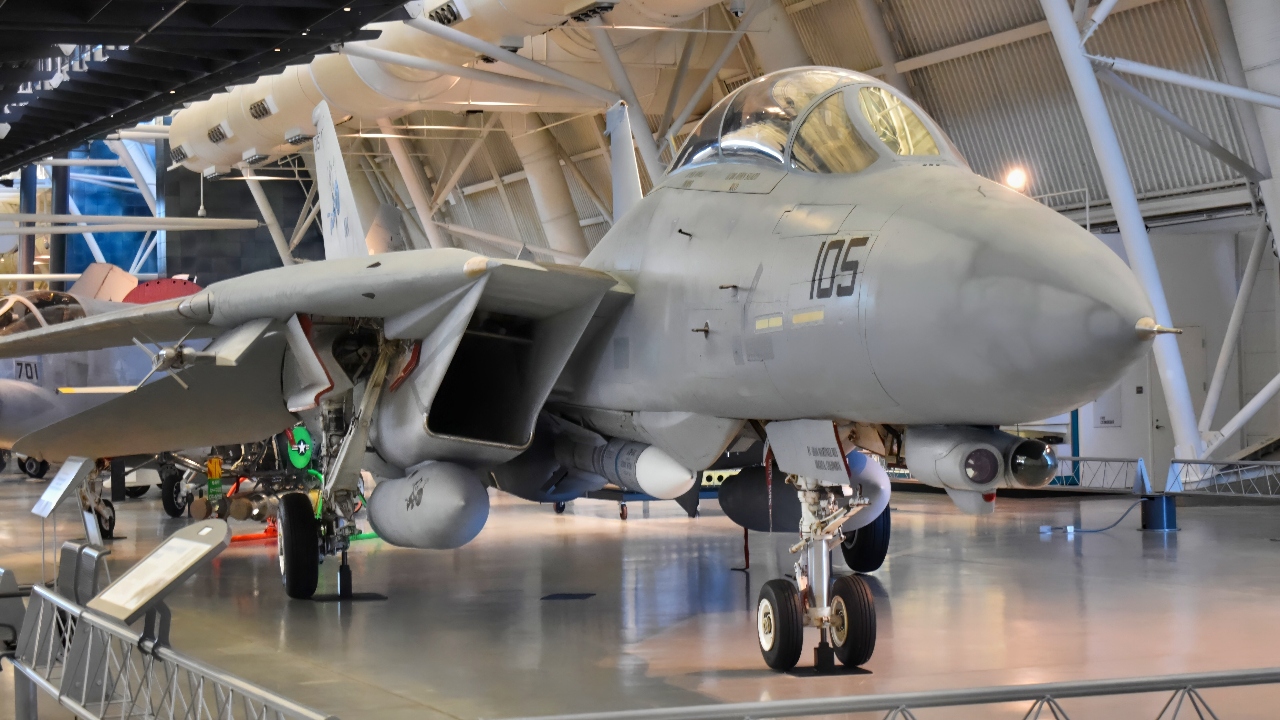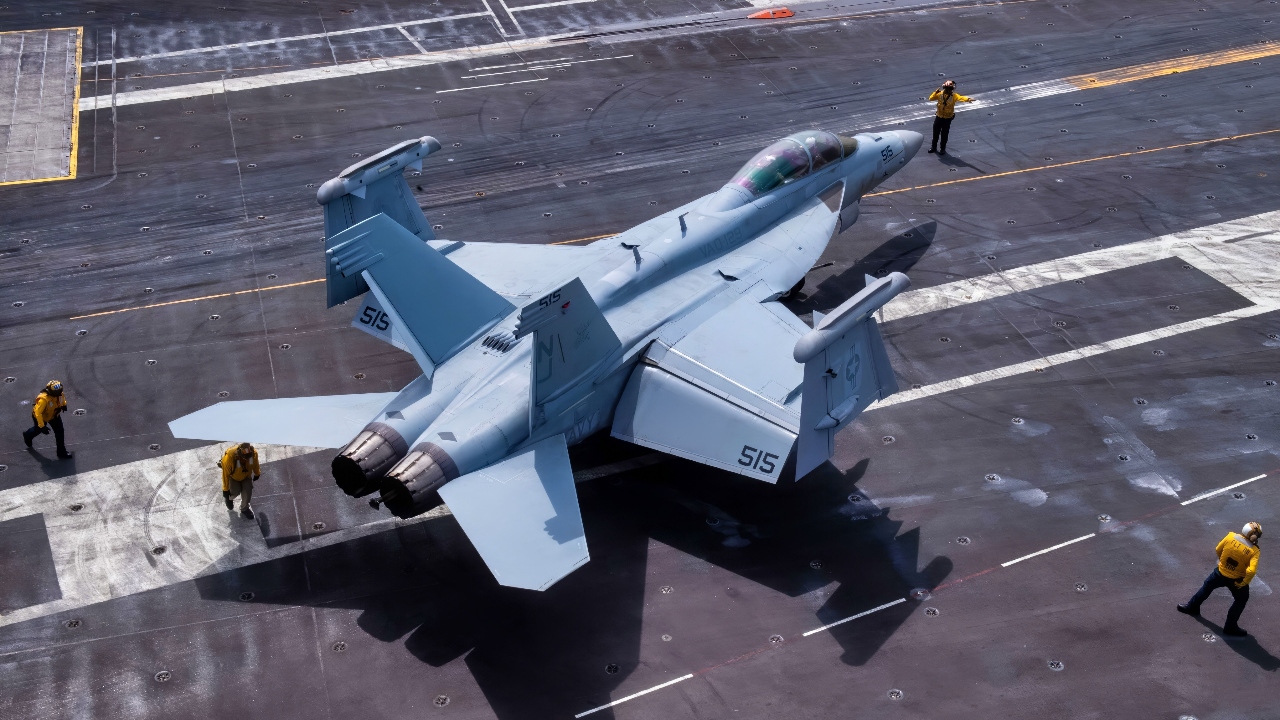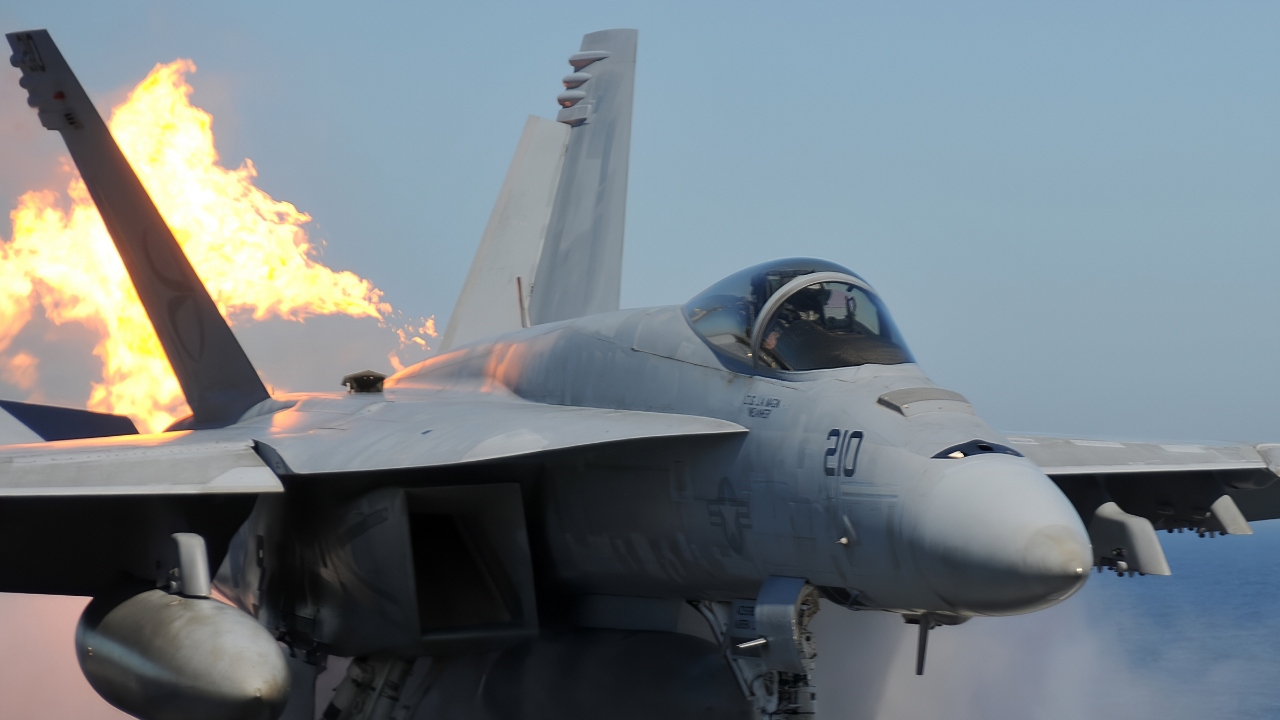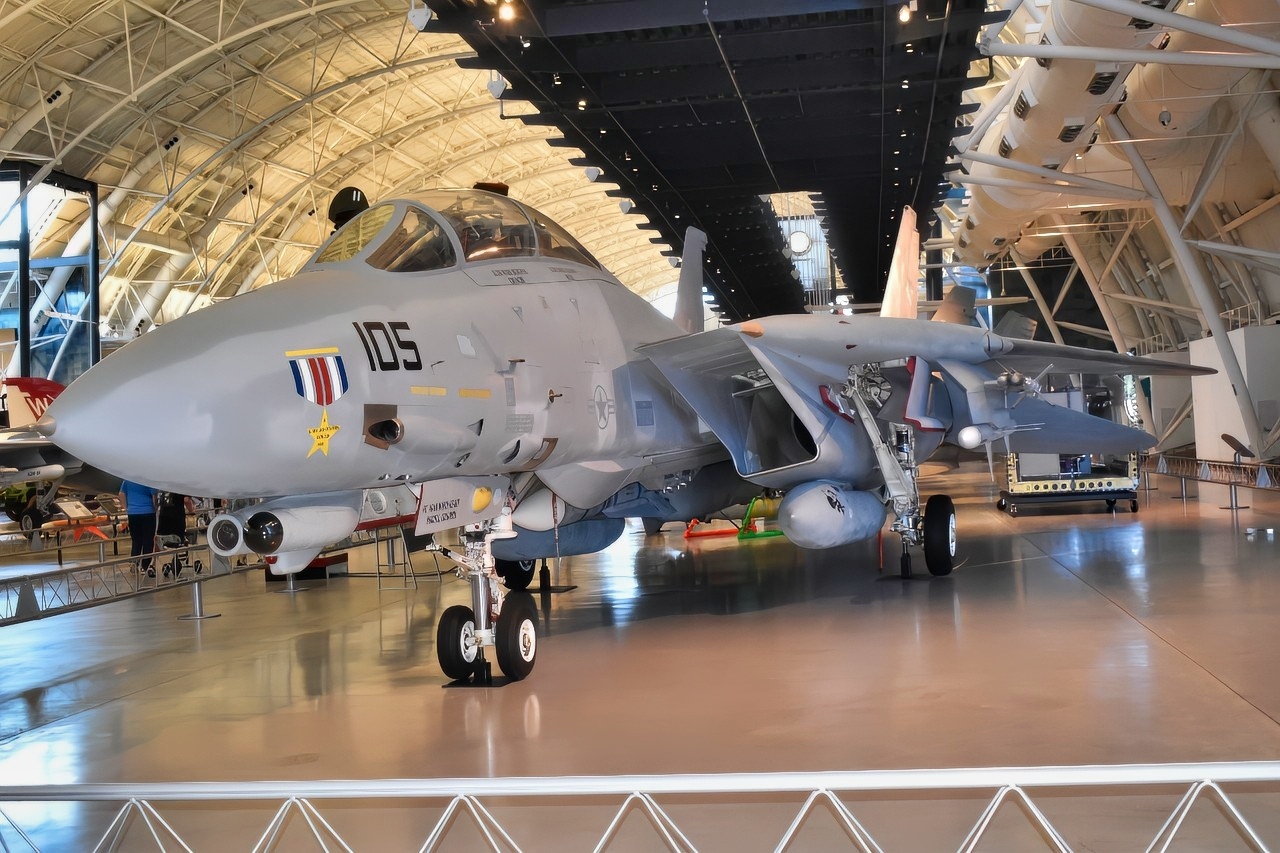Key Points and Summary – The U.S. Navy’s replacement of the F-14 Tomcat with the F/A-18 Super Hornet, as seen in the “Top Gun” films, was driven by cost and a post-Cold War mission shift.
-The F-14 was a specialized, expensive interceptor designed to shoot down Soviet bombers. When that threat disappeared, the Navy needed a more versatile and affordable multirole aircraft.

F-14 Tomcat Fighter National Security Journal Photo
-The newer, easier-to-maintain F/A-18 Super Hornet, designed for both fighter and attack roles, was a better fit. Ultimately, the Super Hornet’s lower operating costs and superior multirole capability made it the logical choice for the modern Navy.
Why Did the F/A-18 Super Hornet Replace the F-14 Tomcat?
The original film in the Top Gun film franchise debuted at the box office way back in 1986, when Ronald Reagan was President of the United States, and five years before the Cold War ended. It took 36 years for the long-awaited sequel, “Top Gun: Maverick,” to finally come out.
In a classic example of art imitating life, in the sequel, the Boeing F/A-18E/F Super Hornet has replaced the venerable Grumman F-14 Tomcat as the US Navy’s frontline carrier-borne fighter plane, just like with real-life American Naval Aviation. However, of course, a gesture of cinematic sentimentality, the ol’ Tomcat (clearly implied as belonging to the Islamic Republic of Iran Air Force [IRIAF] even though not explicitly identified as such) still makes a grand appearance in the 2022 film.
That said, the question naturally arises: Why exactly did the Super Hornet supersede the battle-proven Tomcat? Why wasn’t the so-called “Super Tomcat” variant of the Grumman warbird chosen instead?
Bottom Line Up Front (BLUF)
The short answer comes to us courtesy of military history expert Sébastien Roblin.
As Monsieur Roblin wrote back in October 2016:
“However, the Navy chose instead to field the F-18E/F Super Hornet. The Hornet airframe was not quite as optimized for air-to-air combat, but still delivered excellent performance. It was based on fly-by-wire technology and cost less money and time to fly and maintain. The choice between investing in a Super Tomcat or fielding the Super Hornet inevitably involved a trade-off, and the Super Hornet simply came out ahead in the Navy’s calculus.”
NOTE: For the benefit of any of our readers unfamiliar with fly-by-wire technology, it is a flight control system that replaces hydraulic linkages between the pilot’s controls and the aircraft’s control surfaces with electronic systems.

PACIFIC OCEAN (Aug. 11, 2025) – U.S. Navy Sailors direct an E/A-18G Growler, assigned to the “Vikings” of Electronic Attack Squadron (VAQ) 129, on the flight deck of the Nimitz-class aircraft carrier USS Theodore Roosevelt (CVN 71), Aug. 11, 2025. Theodore Roosevelt, flagship of Carrier Strike Group (CSG) 9, is underway conducting exercises to bolster strike group readiness and capability in the U.S. 3rd Fleet area of operations. (U.S. Navy photo by Mass Communication Specialist Seaman Apprentice Cesar Nungaray)

A U.S. Navy F/A-18E Super Hornet aircraft assigned to Strike Fighter Squadron 137 is launched from the flight deck of the aircraft carrier USS Abraham Lincoln (CVN 72) while underway in the Pacific Ocean on Feb.2, 2009. (DoD photo by Petty Officer 2nd Class James R. Evans, U.S. Navy. (Released))
When the pilot manipulates the control inputs, such as the control stick or yoke, those movements are converted into electronic signals by sensors. From there, those signals are transmitted to a computer or flight control system, which interprets the pilot’s commands and adjusts the position of the control surfaces accordingly. Fly-by-wire provides the pilot with an incredible array of assistance, including significant weight savings and ease of programming envelope protection.
There was also the fact that the Tomcats were getting long in the tooth. The F-14 made its maiden flight on 22 September 1974, and the last one rolled off the Grumman assembly lines in 1991. (Grumman Aerospace Corporation became Northrop Grumman via the merger with Northrop Corporation in April 1994.) By contrast, the F/A-18E/F entered into production phase in 1995 and made its maiden flight that same year.
Shifting Naval Aviation Mission Requirements
The F-14 was designed in 1969 as an interceptor for fleet defense rather than a true dogfighter. It fulfilled a US Navy requirement for an aircraft that could engage multiple supersonic Soviet Naval Aviation bombers, each carrying multiple supersonic anti-ship missiles, before those bombers could launch their weapons against the carrier battle group.
Accordingly, the plane was designed around the Raytheon (Hughes) AIM-54 Phoenix missile, which had a mind-numbing range of 80 nautical miles (92 statute miles; 150 kilometers).
However, with the collapse of the Soviet Union, that requirement for anti-bomber defense was rendered moot. Nowadays, the biggest threat to the carriers is land-based ship-killing missiles.
What’s more, as impressive as the Phoenix missile looked on paper, it underwhelmed in actual combat performance: USN Tomcat drives only initiated a grand total of three confirmed launches with their AIM-54s—all against then-Iraqi strongman Saddam Hussein’s MiGs during the 1991 Persian Gulf War, AKA Operation Desert Storm—and all three Phoenixes missed their targets.
Moreover, although the F-14 could and did drop bombs in combat—the so-called “Bombcat”—it simply didn’t have the multirole versatility, i.e., air-to-ground strikes as well as air-to-air missions, that the Super Hornet does.
This is why the older bird is designated as “F” for “fighter,” whereas the younger one is defined as “F/A” for “fighter/attack.” (Remember, in the original “Top Gun,” Maverick and his comrades-in-arms weren’t tasked with destroying ground targets.)
Tale of the Tape Part I: F/A-18 E/F Super Hornet Technical Specifications & Vital Stats
Fuselage Length: 60 feet 1.25 inches (18.31 meters)
Wingspan: 44 feet 8.5 inches (13.62 meters)
Height: 16 feet 0 inches (4.88 meters)
Empty Weight: 32,081 lb. (14,552 kg)
Gross Weight: 47,000 lb. (21,320 kg)
Max Takeoff Weight: 66,000 lb. (29,937 kg)
Powerplant: 2 × General Electric (GE Aerospace) F414-GE-400 turbofans, each generating 22,000 lbf. (98 kN) of thrust in afterburner mode
Max Airspeed: Mach 1.8
Ferry Range: 1,800 nautical miles (2,070 statute miles; 3,330 kilometers)
Combat Range: 462 nautical miles (532 statute miles; 856 km) on internal fuel only, i.e., sans drop tanks
Service Ceiling: 52,300 feet (15,940 meters)
Armament: 1× 20 mm (0.787 in) General Dynamics M61A2 Vulcan cannon with 412 rounds of ammo; 11 hardpoints with a payload capacity of 17,750 lb. (8,050 kg) of bombs and/or missiles
Tale of the Tape Part Deux: F-14 Tomcat Technical Specifications & Vital Stats
Fuselage Length: 62 feet 9 inches (19.13 meters)
Wingspan: 64 ft 1.5 inches (19.545 meters) fully extended; 38 feet 2.5 inches (11.646 meters) swept back
Height: 16 feet 0 inches (4.88 meters) (yes, same as the F/A-18E/F)
Empty Weight: 43,735 lb. (19,838 kg)
Gross Weight: 61,000 lb. (27,669 kg)
Max Takeoff Weight: 74,350 lb. (33,725 kg)
Powerplant: 2 × GE Aerospace F110-GE-400 turbofans, each generating 26,950 lbf. (119.9 kN) of thrust in afterburner mode
Max Airspeed: Mach 2.34
Ferry Range: 1,600 nautical miles (1,800 statute miles; 3,000 kilometers)
Combat Range: 503 nautical miles (579 statute miles; 932 kilometers)
Service Ceiling: In excess of 53,000 feet (16,000 meters)
Armament: 1× 20 mm (0.787 in) M61A1 Vulcan gun, with 675 rounds of ammo; 10 hardpoints with a payload capacity of 14,500 lb. (6,600 kg) of missiles and/or bombs
About the Author: Christian D. Orr, Defense Expert
Christian D. Orr is a Senior Defense Editor. He is a former Air Force Security Forces officer, Federal law enforcement officer, and private military contractor (with assignments worked in Iraq, the United Arab Emirates, Kosovo, Japan, Germany, and the Pentagon). Chris holds a B.A. in International Relations from the University of Southern California (USC) and an M.A. in Intelligence Studies (concentration in Terrorism Studies) from American Military University (AMU).
More Military
RANKED: 5 Worst Fighter Jets Ever
Vanguard: Meet the Very Last Battleship Ever Built
JAS 39: The Best Fighter Jet Not Named F-22 or F-35? You Decide
Step Aboard USS Iowa: The Iowa-Class Battleship That ‘Could’ Fight Again










